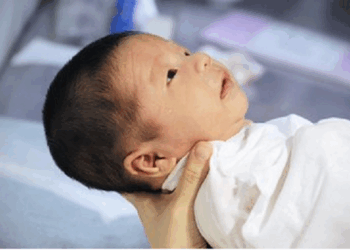In the fall of 2010, the Heritage Foundation was invited to send a speaker to a charter school class in the District of Columbia to discuss abortion. I was nominated for the task and arrived that morning at the Cesar Chavez Public Charter School for a back-and-forth with a representative from the D.C.-area Planned Parenthood.
The classroom had approximately 30 students, nearly all female and mostly freshmen and sophomores. It proved to be a good, low-key exchange, during which I learned the young women had been given a tour of a local Planned Parenthood facility. The classroom was not set up for audio visuals, and I had planned to dwell primarily on talking points about the value of life and setting behavioral standards necessary for personal success and happiness. But I did bring with me a set of visuals depicting the development of the child in the womb — straightforward prenatal biology and not violent images. The pictures were accurate and beautiful.
At the end of my presentation, I turned the images over to the young ladies and urged them to pass them around. The effect was electric. The girls emitted gasps of excitement and circulated the pictures eagerly. I took a few moments to explain how the images were secured and some basic points on each stage of development. Later, it struck me how odd it was that a group of young women had been chaperoned to a “parenthood” clinic and had not been shown a single photograph of what a developing child looks like. What did the D.C. Planned Parenthood show them? It wasn’t hard to conjecture what the girls didn’t see on their tour of a local clinic. Their excitement over the photos of babies in the womb encouraged me, but then I realized how likely it was that the vast majority of D.C. students would not see any images of unborn human beings before an encounter with the largest abortion agency in America and perhaps the world.
HELP LIFENEWS SAVE BABIES FROM ABORTION! Please help LifeNews.com with a donation!
To some degree, of course, that egregious omission in education about family and sexuality is now public policy. As many as two-thirds or more of abortions are carried out by chemical means. Thanks to successive decisions by the Food and Drug Administration, some of them in the wake of the COVID scare, these pregnancy-destroying drugs are mailed to women and girls without their ever having seen a physician in person or having obtained and viewed an ultrasound.
In the wake of the 2022 Dobbs decision, abortion policy has been largely devolved to the states, with the key federal role enabling mifepristone and misoprostol to be shipped directly to women (or to third parties) to administer. Across the country, Planned Parenthood facilities are closing, but the abortion trade has changed so dramatically that it is not clear that these closures, welcome as they are, will materially affect abortion rates. As long as the FDA approval stands, and the failure to enforce laws against shipping abortion drugs via the mail endures, brick-and-mortar abortion centers will continue to contract. Planned Parenthood’s closures are just a reminder how much the organization physically depends on its abortion emphasis.
In the wake of Dobbs, it is clearer than ever that education about the reality of life in the womb is urgent. Seeing one’s own child in utero is, to be sure, no guarantee that more choices for life will be made. But many such decisions will be made one way or the other, and it is a duty of practitioners of science education and medicine to ensure that every child learns, at an age-appropriate level, how each of us is “fearfully and wonderfully made.” This reality has put fresh emphasis on the creation of new resources to ensure that young women and men know the biology of their own offspring and that these resources are accurate and well-crafted.
Fortunately, there is a wide variety of resources available at diverse levels of detail and sophistication, but all with superb documentation. What follows is a summary of several of these resources.
Baby Olivia
This video animation, more than three minutes long, depicts the landmarks of development of a child in the womb, from fertilization, to implantation, to such steps along the way as a detectable heartbeat (22 days after fertilization); the child’s ability to bring her hands together (7-1/2 weeks); suck her thumb (nine-10 weeks); ability to survive, with medical support, outside the womb (20 weeks); and sensitivity to light (27 weeks).
The video was produced by the organization Live Action based in Washington, D.C. Its medical accuracy was reviewed and certified by a group of leaders in obstetrics and gynecology and related fields. A number of state legislatures have taken steps to include the Baby Olivia materials in public school biology curricula, including North Dakota and Tennessee where it is incorporated in curriculum via state law. Similar measures have been introduced but not yet passed in Missouri, Ohio, Iowa, West Virginia, Kentucky, Nebraska, and Arkansas.
Window to the Womb
Live Action has also released a unique Window to the Womb app, which depicts each day of the unborn child’s development from fertilization to birth. The app is interactive, allowing the viewer to pause the visual and access information about each particular stage of pregnancy.
The Voyage of Life
This site, which includes video images and a week-by-week elaboration of changes as human life develops prenatally, provides detailed information and sourcing for its many revelations about the miracle of life. Created by a team helmed by Tara Sander Lee, who possesses a Ph.D. in biochemistry from the Medical College of Wisconsin and did postdoctoral training at Harvard Medical School and Boston Children’s Hospital, the Voyage of Life delves into a range of compelling topics. It addresses such questions as fetal surgery before a baby is born, responding in a life-affirming way to fetal anomalies, the appearance of right- and left-handedness in the prenatal child, first heartbeat and neural tube development, and many other subjects of interest. Like Baby Olivia, it is captivatingly presented with nothing graphic shown.
Contend Projects
Contend Projects is an organization that describes itself as “a secular, nonpartisan, science education nonprofit with the mission to spread accurate information and awareness about the biological science of human embryology and when a human being begins to exist.” Contend actively seeks to influence the accuracy and quality of K-12 science education standards in the states. Its website offers a creative variety of materials for individual and group use.
Contend focuses on consensus science regarding the Carnegie stages of development, facts which it asserts everyone should know in the midst of current debates over the value of human life. Contend Projects founder Brooke Stanton says, “I believe we should be just as comfortable talking about when a human life begins as we are talking about free-range eggs or chemicals in our personal care products.”
The Endowment for Human Development
Another invaluable source of images and information is the Endowment for Human Development (EHD), perhaps the most comprehensive resource available addressing the details of embryonic development. The site is available in Spanish and Portuguese and contains sections focusing on particular aspects of development and specific organs, including “the heart slideshow,” “eyes, ears, mouth and nose,” and “the developing brain.”
EHD’s directors, staff, and volunteers represent an array of subject matter experts, researchers, clinicians, and others who, it says, “share the common goal of improving lifelong health through prenatal development-based education.” The site stipulates that it is committed to “neutrality regarding all controversial bioethical issues.” The evidence assembled stands on its own.
In many ways, the reality of fetal life is common knowledge — ultrasound images of the developing child have become a feature of everyday life, improving in quality and adorning many a refrigerator in American households. Seeing such images in a movie theater, in television advertising or dramas, is commonplace. Advances in corrective procedures for babies before birth occur regularly, and stories from this medical frontier are exhilarating. But despite these changes, it is not yet commonplace for school curricula to impart a high level of knowledge about how each of us came to be. Major news media seldom, if ever, include images of the children whose lives are at stake in the raging debates over the right to live.
Every so often, a major outlet will release an updated account of life in the womb, like 1977’s “The Miracle Months” and the heart-wrenching 2017 CBS report on how prenatal screening and abortion are leading to the eradication of children with Down syndrome in Iceland. More explorations like these are needed, and many more stories exist to be told about the extraordinary nature of human reproduction and the heroism of men and women who have led the way for protection and treatment of these little ones.
No woman contemplating abortion should be deprived of knowledge, preferably sparked early in life, of the wonder or wonders she carries within her.
LifeNews Note: Chuck Donovan is a 50-year veteran of the national debate over the right to life and served from 1981-89 as a writer in the Reagan White House.He is the former Executive Vice President of Family Research Council.





![Hegseth Demands Fitness Requirements, Says 'Fat Troops' 'Not Who We Are' [WATCH]](https://teamredvictory.com/wp-content/uploads/2025/09/Hegseth-Demands-Fitness-Requirements-Says-Fat-Troops-Not-Who-We-350x250.jpg)






